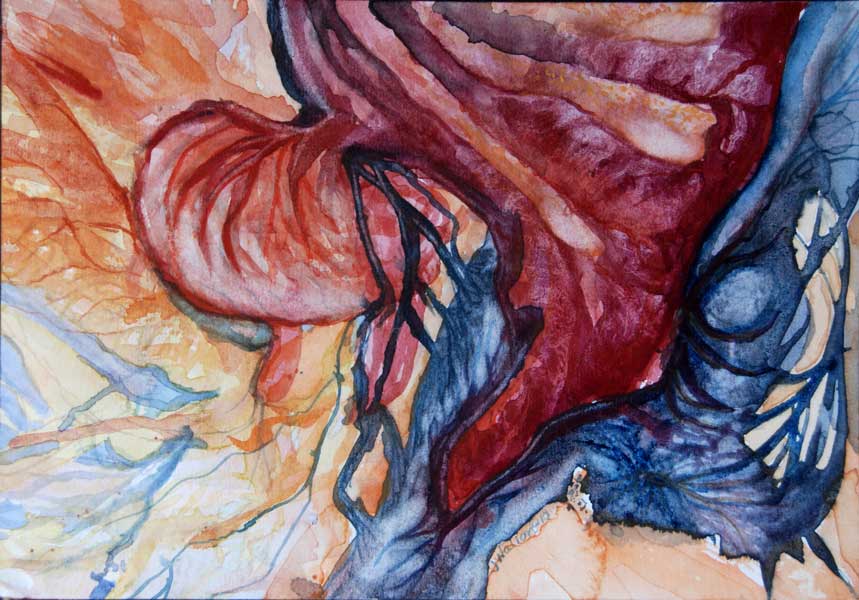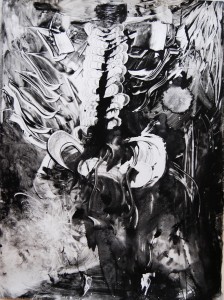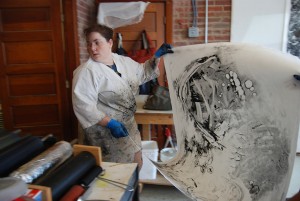
Recently, I have worked largely in monotypes – one-of-a-kind prints that are painterly in execution and in effect. A residency at Pyramid Atlantic in Silver Spring gave me access to the best printmaking equipment and time to experiment. My work involves the suspension of faith in science and organized belief systems; I question commonly -held “truths” through my personal experience in the process of making art and the physical destruction and reconstruction of the body. By dealing with the beautiful, horrific, and sublime nature of the human body, I work toward an evolving sense of the spirituality and physicality of being human.
In much of the work, I envisioned the rib cage as a structural and metaphorical stabilizer within each composition. It offers protection, structure, and containment, much like organized religion. The often abstracted and wildly expressive landscapes outside of the ribcage allude to a constantly changing realm of scientific discovery that challenges established belief systems. These monotypes were created by painting and drawing into ink on YUPO polypropylene sheeting the size of the full press bed. Using this material as the printing matrix emphasizes fluidity and spontaneity.
I worked in suites of prints, building upon or destroying parts of the previous composition to further ideas and elements in the next. At the beginning of each suite, I would utilize imagery from anatomy books, x-rays of my own body, and photography to create the initial composition. As I worked further into the suite, those representational images would either be obliterated or emphasized, depending on the response to my physical awareness of previous injuries to my body. As my own physical stamina decreased in the course of long printing sessions, so too did the representation of human anatomy in the work.
 Physical endurance during my artistic practice has become a key factor in my work. As I reached for larger ranges of motion and pushed the limits of my physical ability and mark-making, the pieces reflect my response to thoughts of spirituality, mortality, and the metaphors of human life and its evolving relationships to the world.
Physical endurance during my artistic practice has become a key factor in my work. As I reached for larger ranges of motion and pushed the limits of my physical ability and mark-making, the pieces reflect my response to thoughts of spirituality, mortality, and the metaphors of human life and its evolving relationships to the world.
Recently my work has taken some new directions that are also inspired by the limitations of the physical body. Shortly after my residency, I had a serious fall that required a long healing process on multiple limbs. My studio practice has suffered significantly. It felt like being on a speeding freight train, then coming to a sudden halt without notice. It hasn’t been easy to work in the last year; it feels stilted, rusty, and painful. But the key is, I continue to try. The physicality of the work that I was enjoying in the residency, using my whole body to work on increasingly larger images, is no longer accessible. I had to try to figure out how to translate the marks, ideas, and methods that I discovered at Pyramid Atlantic into something more manageable from the sitting or reclining positions that I can maintain.
My best friend, who understands my frustrations, dared me to try working with my left hand while the right arm heals, and I took the dare. Training my left hand to respond to my brain’s directions takes great concentration. It requires doing the opposite of what comes naturally.
Using my left hand, I have been working very small. It’s strange to me how a 5” x 7” piece of watercolor paper can become intimidating, when just last year, 60” x 30” inches seemed too small. With each piece, both my body and ability gets better. While at this moment I’m concentrating more on regaining my skills, I can’t keep the content from emerging. The small intimate pieces have become meditations on healing. While my work in the last several years has addressed the healing process, it has never been quite so important that the work also BE the healing process.
 Jenny Walton was born in Spokane, Washington. She received her MFA from American University, which included a year in Italy. Walton has received the Joanne Crisp Ellert Award of Excellence and two Mellon Research Grants. She has shown work at Daneyal Mahmood Gallery in New York, Pierre Menard Gallery in Cambridge, Pyramid Studio in Rome, and is included in the American University Watkins Collection and the District of Columbia Art Bank. Residencies include the Chautauqua School of Art and Pyramid Atlantic Art Center. She currently lives and works in the Washington, D.C. metro area.
Jenny Walton was born in Spokane, Washington. She received her MFA from American University, which included a year in Italy. Walton has received the Joanne Crisp Ellert Award of Excellence and two Mellon Research Grants. She has shown work at Daneyal Mahmood Gallery in New York, Pierre Menard Gallery in Cambridge, Pyramid Studio in Rome, and is included in the American University Watkins Collection and the District of Columbia Art Bank. Residencies include the Chautauqua School of Art and Pyramid Atlantic Art Center. She currently lives and works in the Washington, D.C. metro area.
Edited by Ellyn Weiss